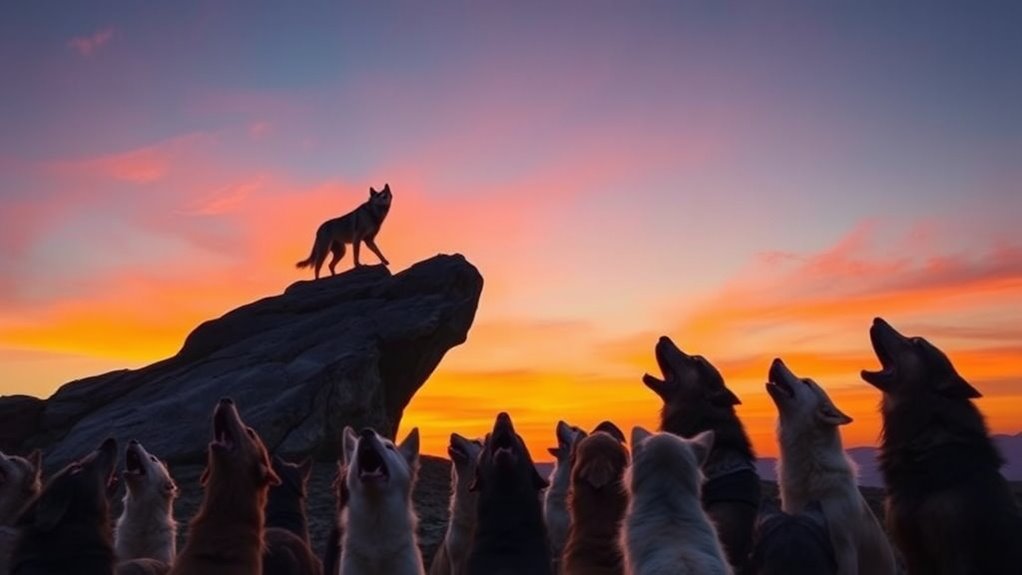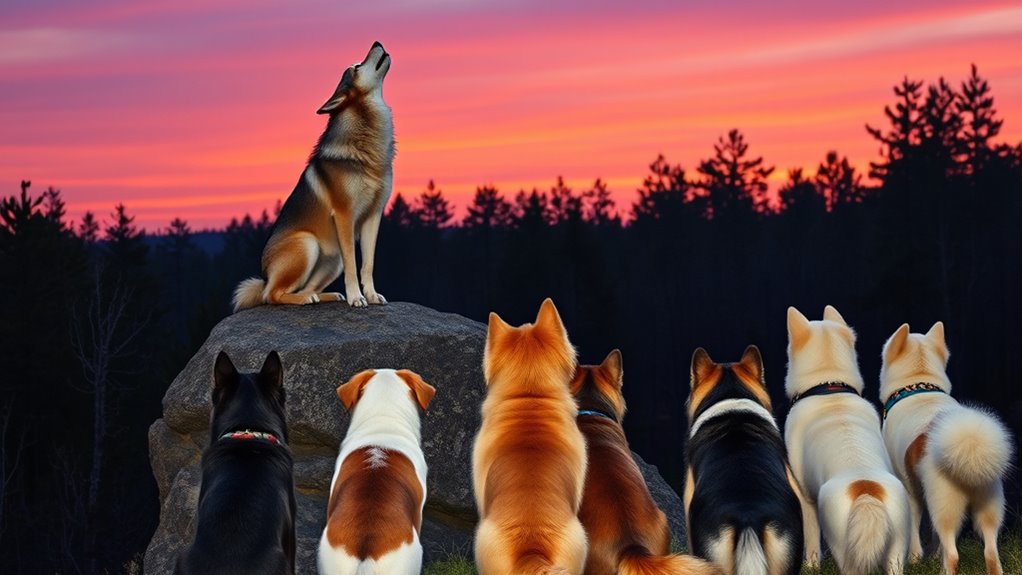Dogs howl due to an instinctual behavior passed down from their wild ancestors, like wolves. This primal form of communication helps them connect with you and other animals nearby. When they hear certain sounds, like sirens or music, it can trigger howling as a response. They may also howl when they feel anxious or seek attention. Understanding their howling can strengthen your bond with them, and there’s so much more to discover about this fascinating behavior.
Key Takeaways
- Howling is an inherited behavior from wild ancestors like wolves, used for communication within the pack.
- Dogs howl to connect with humans or other animals, expressing their presence or need for companionship.
- Environmental sounds, such as sirens or music, can trigger howling responses, mimicking pack behavior.
- Dogs may howl due to separation anxiety or stress, signaling their emotional state or need for reassurance.
- Howling can be attention-seeking behavior, reinforced by owners responding to their vocalizations.

Have you ever wondered why your dog howls at night? It’s a fascinating behavior that’s deeply rooted in their evolutionary past. When your pup raises its head and lets out a long, drawn-out howl, it’s not just making noise; it’s tapping into instincts inherited from their wild ancestors. Understanding this ancient form of communication can shed light on why your dog engages in this behavior, especially when the moon is high and the world is quiet.
Discover the fascinating reasons behind your dog’s howling, a behavior rooted in their ancestral instincts and communication.
Howling is one of the many dog vocalizations that serve various purposes. In the wild, wolves howl to communicate with their pack. They use this vocalization to locate one another, signal their presence, or even warn others of potential threats. Your dog, though domesticated, still shares this instinctual drive. When it howls, it’s often trying to connect with you or alert you to something it perceives in its environment.
You might notice your dog howling in response to certain sounds, like sirens or music. This can be attributed to their pack behavior. Dogs are social animals, and they crave connection. When they hear howling or similar sounds, it might trigger their natural instinct to join in, almost as if they’re replying to a distant pack member. It’s their way of saying, “Hey, I’m here!” or “I’m part of this family.” If your dog has been separated from you or feels anxious, howling can also be a way to express that they’re looking for reassurance or company.
Moreover, howling can be a form of attention-seeking behavior. If your dog realizes that howling gets your attention—whether it’s positive or negative—they might use it as a way to interact with you. If you respond by calling them or coming to investigate, they’ll learn that their vocalization successfully engages you, reinforcing the behavior.
Understanding your dog’s howling can deepen your bond with them. When you recognize this behavior as a form of communication rooted in pack dynamics, you can respond more effectively. Whether it’s comforting your pup during a stressful moment or understanding their need for connection, acknowledging their instincts can enhance your relationship. Additionally, dogs’ vocalizations, including howling, can vary in pitch and tone, which may indicate different emotions or intentions, highlighting the importance of color accuracy in their vocal expressions. So the next time your dog howls, take a moment to appreciate the rich history behind that sound, and know that it’s just another way they’re expressing their connection to you and their world.
Frequently Asked Questions
Can All Dog Breeds Howl, or Only Specific Ones?
Yes, all dog breeds can howl, but breed differences and genetic factors influence how often and how effectively they do it. Some breeds, like hounds, are more prone to howling due to their ancestry and vocalization patterns. Others may not howl as frequently or at all. So, if you’ve got a breed known for its vocal talents, you might hear more howling compared to a quieter breed.
Do Puppies Howl, or Is It Only Adult Dogs?
Yes, puppies do howl! Just like a toddler’s first attempt at singing, a puppy’s howl is a charming step in their development. Early on, they might howl to communicate with their littermates or get your attention. As they grow, this behavior helps them express emotions and connect with you, showcasing their unique way of canine communication. So, when your puppy howls, it’s their adorable way of finding their voice in the world!
How Can I Stop My Dog From Howling Excessively?
To stop your dog from howling excessively, try implementing effective training techniques. Consistency is key, so reinforce quiet behavior with treats or praise. Additionally, provide environmental enrichment—engage your dog with toys, puzzles, or interactive games. This keeps them mentally stimulated and less likely to howl out of boredom. If the howling persists, consider consulting a professional trainer who can help tailor a plan specifically for your dog’s needs.
Are There Specific Times When Dogs Howl More Often?
Yes, there are specific times when dogs howl more often. You might notice your dog vocalizing during environmental triggers like sirens, other dogs howling, or even during thunderstorms. These sounds can provoke their instinctual response to communicate. While you may think it’s excessive, remember that howling is a natural part of their behavior. Pay attention to these moments; they can help you understand your dog’s needs and feelings better.
Is Howling a Sign of Distress in Dogs?
Yes, howling can be a sign of distress in dogs. When you notice your dog vocalizing in this way, it’s crucial to observe their overall behavior. They might be feeling lonely, anxious, or even in pain. Canine behavior often includes various animal vocalizations, and howling is just one way your dog expresses its feelings. If it seems excessive or unusual, consider consulting a vet to verify everything’s okay.
Conclusion
In the symphony of canine communication, howling is a haunting melody that echoes through the ages. It’s a bridge between the wild ancestors and the loyal companions we cherish today. When your dog raises its voice to the moon, it’s not just a call; it’s a connection to their roots, a reminder of their pack instincts. So, next time you hear that soulful serenade, remember: you’re not just listening; you’re experiencing a timeless dance of evolution and emotion.










